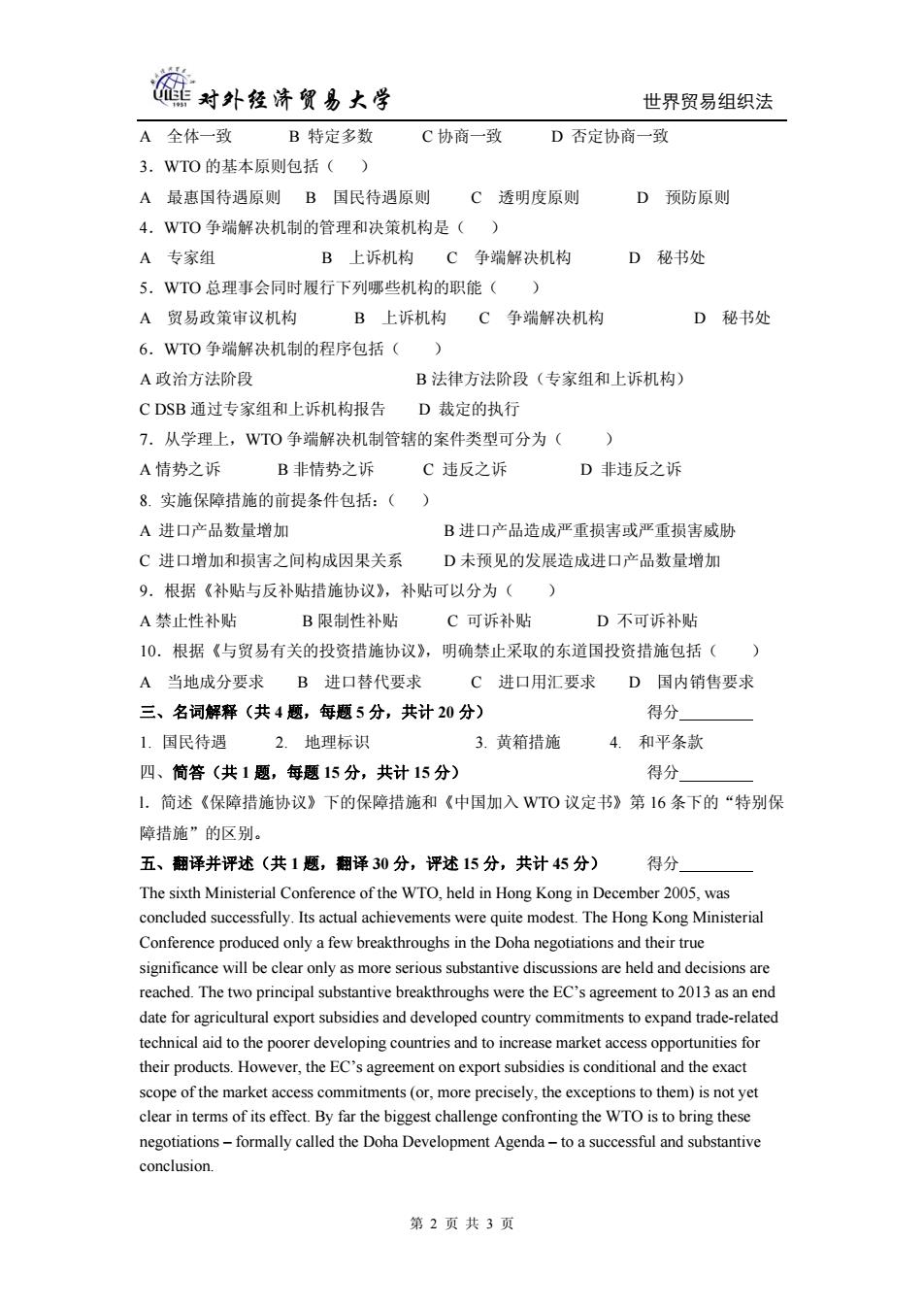正在加载图片...

对外经济贸易大学 世界贸易组织法 A全体一致 B特定多数 C协商一致 D否定协商一致 3.WTO的基本原则包括() A最惠国待遇原则B国民待遇原则 C透明度原则 D预防原则 4.WTO争端解决机制的管理和决策机构是() A专家组 B上诉机构C争端解决机构 D秘书处 5.WTO总理事会同时履行下列哪些机构的职能() A贸易政策审议机构 B上诉机构C争端解决机构 0 秘书处 6.WTO争端解决机制的程序包括() A政治方法阶段 B法律方法阶段(专家组和上诉机构) CDSB通过专家组和上诉机构报告D裁定的执行 7.从学理上,WTO争端解决机制管辖的案件类型可分为( A情势之诉 B非情势之诉 C违反之诉 D非违反之诉 8.实施保障措施的前提条件包括:() A进口产品数量增加 B进口产品造成严重损害或严重损害威胁 C进口增加和损害之间构成因果关系 D未预见的发展造成进口产品数量增加 9.根据《补贴与反补贴措施协议》,补贴可以分为() A禁止性补贴 B限制性补贴 C可诉补贴 D不可诉补贴 10.根据《与贸易有关的投资措施协议》,明确禁止采取的东道国投资措施包括( A当地成分要求B进口替代要求 C进口用汇要求 D国内销售要求 三、名词解释(共4题,每题5分,共计20分) 得分」 1.国民待遇 2.地理标识 3.黄箱措施 4.和平条款 四、简答(共1题,每题15分,共计15分) 得分 L.简述《保障措施协议》下的保障措施和《中国加入WTO议定书》第16条下的“特别保 障措施”的区别。 五、翻译并评述(共1题,翻译30分,评述15分,共计45分) 得分 The sixth Ministerial Conference of the WTO,held in Hong Kong in December 2005,was concluded successfully.Its actual achievements were quite modest.The Hong Kong Ministerial Conference produced only a few breakthroughs in the Doha negotiations and their true significance will be clear only as more serious substantive discussions are held and decisions are reached.The two principal substantive breakthroughs were the EC's agreement to 2013 as an end date for agricultural export subsidies and developed country commitments to expand trade-related technical aid to the poorer developing countries and to increase market access opportunities for their products.However,the EC's agreement on export subsidies is conditional and the exact scope of the market access commitments (or,more precisely,the exceptions to them)is not yet clear in terms of its effect.By far the biggest challenge confronting the WTO is to bring these negotiations-formally called the Doha Development Agenda-to a successful and substantive conclusion. 第2页共3页对外经济贸易大学 世界贸易组织法 第 2 页 共 3 页 A 全体一致 B 特定多数 C 协商一致 D 否定协商一致 3.WTO 的基本原则包括( ) A 最惠国待遇原则 B 国民待遇原则 C 透明度原则 D 预防原则 4.WTO 争端解决机制的管理和决策机构是( ) A 专家组 B 上诉机构 C 争端解决机构 D 秘书处 5.WTO 总理事会同时履行下列哪些机构的职能( ) A 贸易政策审议机构 B 上诉机构 C 争端解决机构 D 秘书处 6.WTO 争端解决机制的程序包括( ) A 政治方法阶段 B 法律方法阶段(专家组和上诉机构) C DSB 通过专家组和上诉机构报告 D 裁定的执行 7.从学理上,WTO 争端解决机制管辖的案件类型可分为( ) A 情势之诉 B 非情势之诉 C 违反之诉 D 非违反之诉 8. 实施保障措施的前提条件包括:( ) A 进口产品数量增加 B 进口产品造成严重损害或严重损害威胁 C 进口增加和损害之间构成因果关系 D 未预见的发展造成进口产品数量增加 9.根据《补贴与反补贴措施协议》,补贴可以分为( ) A 禁止性补贴 B 限制性补贴 C 可诉补贴 D 不可诉补贴 10.根据《与贸易有关的投资措施协议》,明确禁止采取的东道国投资措施包括( ) A 当地成分要求 B 进口替代要求 C 进口用汇要求 D 国内销售要求 三、名词解释(共 4 题,每题 5 分,共计 20 分) 得分 1. 国民待遇 2. 地理标识 3. 黄箱措施 4. 和平条款 四、简答(共 1 题,每题 15 分,共计 15 分) 得分 l.简述《保障措施协议》下的保障措施和《中国加入 WTO 议定书》第 16 条下的“特别保 障措施”的区别。 五、翻译并评述(共 1 题,翻译 30 分,评述 15 分,共计 45 分) 得分 The sixth Ministerial Conference of the WTO, held in Hong Kong in December 2005, was concluded successfully. Its actual achievements were quite modest. The Hong Kong Ministerial Conference produced only a few breakthroughs in the Doha negotiations and their true significance will be clear only as more serious substantive discussions are held and decisions are reached. The two principal substantive breakthroughs were the EC’s agreement to 2013 as an end date for agricultural export subsidies and developed country commitments to expand trade-related technical aid to the poorer developing countries and to increase market access opportunities for their products. However, the EC’s agreement on export subsidies is conditional and the exact scope of the market access commitments (or, more precisely, the exceptions to them) is not yet clear in terms of its effect. By far the biggest challenge confronting the WTO is to bring these negotiations – formally called the Doha Development Agenda – to a successful and substantive conclusion